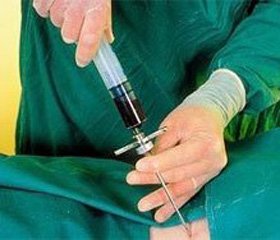Журнал «Боль. Суставы. Позвоночник» 1 (09) 2013
Вернуться к номеру
Bone Biopsy in the Estimation of Bone Tissue
Авторы: Resch H., Medical University Vienna, Department II Rheumatology/Osteology & Gastroenterology
KH Barmherzige Schwestern (St. Vincent Hospital), Academic Teaching Hospital of the Medical University Vienna, 1060 Vienna, Stumpergasse 13, Austria
Рубрики: Ревматология, Травматология и ортопедия
Разделы: Медицинские форумы
Версия для печати
Тезисы докладов Международной школы-семинара «Остеопороз в травматологии и ортопедии»
4–8 февраля 2013 года, г. Яремче, Украина
Abstract. Bone biopsies are performed to analyse bone quality like mineralization and structural patterns and to estimate material properties, by histomorphometry bone turnover can be defined. Furthermore treatment effects on bone structure and bone turnover can be measured. Invasive procedures are restricted to a subgroup of patients with untypical, unclear and complicated pattern. This report tries to evaluate its role and relevance in routine use, which is a topic of permanent controversial discussion. New techniques such as qBEI, µCT, molecular morphometry (in situ hybridization and immunohistochemistry) and analysis of bone material properties have been applied to decalcified bone and elucidate pathogenetic mechanisms or abnormalities on deeper levels of the bone hierarchy. A total of 165 transiliac bone biopsies, their histological diagnoses and the methodologic work up are introduced in the following report. Additionally the 2 most recent studies and their clinical implications are presented.
Introduction and background. Osteoporosis has been characterised and defined as a systemic metabolic bone disease causing a deterioration of skeletal tissue and mechanical competences. The advanced understanding of osteoporosis, however, has changed markedly during the last years. The impact of the classic histopathology has been replaced by a structural, mechanical, genetic and material related understanding. From the clinical standpoint, noninvasive diagnostic procedures have become established and seem to make it very easy to get a correct clinical diagnosis.
Bone biopsy has been restricted so far to untypical, unclear and complicated cases in evidencebased guidelines on diagnosis and treatment of osteoporosis. However, with respect to the tremendous progress in structural and genetical analysis of bone tissue and on the other hand with respect to the progress in the development of new pharmacotherapy, the indication for the assessment of bone tissue has switched to younger patients, even children, males and patients with a substantial discrepancy in the clinical exploration. There is a permanent controversial discussion about performing bone biopsies, the way of preparing and conserving the sample and their correct interpretation to differentiate between lowturnover and highturnover osteoporosis and different architectural patterns in the cortical and trabecular area with impact on therapeutic decisions. In this context, our report gives a description of the science network, the clinical procedure and the impact of the role and relevance of bone biopsy in a medical center, which is responsible for different clinical tasks; basic and clinical research, students training and clinical routine in the management of skeletal diseases.
Patients. In the time period between April 1995 and December 2012, a total of 165 transiliac bone biopsies were performed at the II. Medical Department of Rheumatology/Osteology of the St. Vincent Hospital Vienna in cooperation with the Medical University of Vienna. The indications for a bone biopsy were as following:
Differential diagnosis of bone diseases:
— in particular juvenile (premenopausal) osteoporosis (DD Osteogenesis imperfecta);
— male osteoporosis and fractures after inadequate traumas;
— clinical discrepancies — fractures at normal or osteopenic BMD measurements;
— hyperostosis;
— fragility fractures in young patients;
— nonresponders to antiresorptive therapy;
— scientific investigations & studies.
The aims of the procedure in general are:
— analysis of microarchitecture and material properties (mineralization);
— analysis of mRNA extraction on tissue level;
— genderspecific differences in structure and metabolic dynamics;
— initiation of specific therapies.
Apart the valuable clinical information presented 2 recent studies are going to be presented as an example of the potential in patient oriented research.

